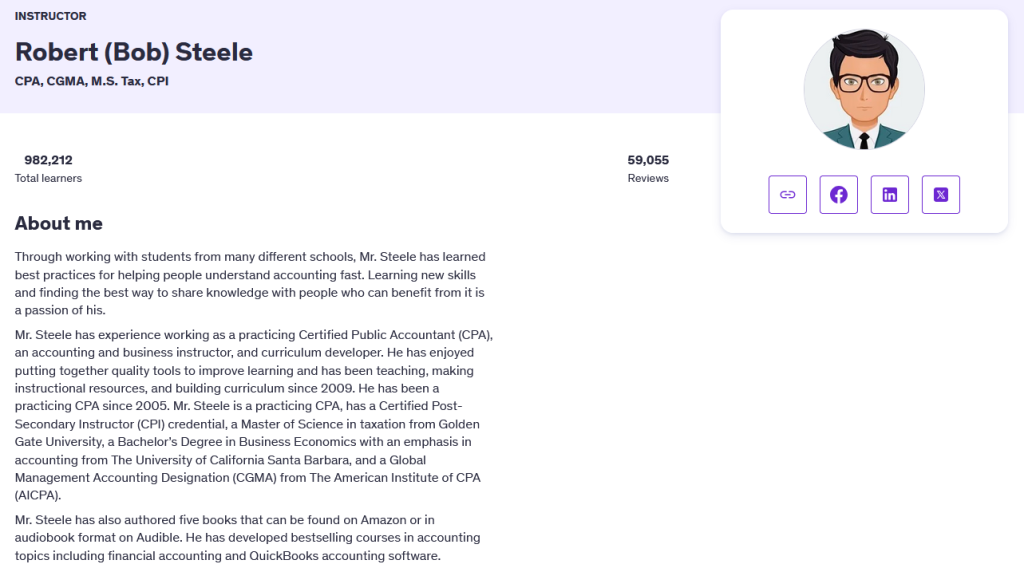If you’ve ever scratched your head trying to understand the difference between finance, accounting, and economics—or how they all fit together in the real world of business—this course might just be your lightbulb moment. Corporate Finance #1: Introduction & Financial Statements by Robert (Bob) Steele is a beginner-friendly dive into the core building blocks of corporate financial decision-making. It’s not just about crunching numbers—it’s about understanding why the numbers matter and how they help businesses thrive (or fail).
Whether you’re a business owner trying to make better calls, a student studying finance, or someone who just wants to get a grip on how companies manage money, this course is designed to walk you through the basics with clarity, structure, and hands-on practice—especially if you love working in Excel.
Instructor Reputation
When it comes to online finance education, Robert (Bob) Steele is a name that frequently pops up—and for good reason. With over 982,000 students enrolled and more than 59,000 reviews, Bob has built a reputation for being one of the most prolific and approachable instructors in the accounting and finance space on Udemy. But numbers only tell part of the story. What really makes him stand out is the unique blend of technical expertise, teaching experience, and pedagogical thoughtfulness he brings to every course.

Bob isn’t just an online instructor; he’s a Certified Public Accountant (CPA), a Chartered Global Management Accountant (CGMA), and holds a Master’s in Taxation from Golden Gate University. He’s been a practicing CPA since 2005 and has taught accounting in both traditional and online settings for well over a decade. His resume also includes developing over 160 courses, authoring finance and accounting books, running a YouTube channel, and building supplemental learning tools like Excel templates and practice worksheets. He’s even developed audio content through podcasts—perfect for learners who prefer to absorb information on the go.
One of the most impressive aspects of Bob’s teaching is how he breaks down difficult material into manageable, engaging segments. Finance and accounting are notorious for being intimidating to beginners, but Bob’s style is about demystifying the jargon and making concepts relatable. He leverages color-coded presentations, step-by-step Excel tutorials, and practical examples to ensure that learners don’t just memorize definitions—they actually understand how to apply them.
Students regularly praise him for being clear, methodical, and thorough. Yes, some may find parts of the course a little repetitive—but for many learners, that repetition helps solidify understanding. Bob’s teaching philosophy centers around the idea that adult learners want utility—they don’t just want to learn something for a test; they want to use it in the real world. And that’s exactly what his courses aim to deliver.
All in all, Robert Steele is not just well-qualified—he’s deeply invested in student success, and it shows in every element of this course.
Course Structure
The structure of Corporate Finance #1: Introduction & Financial Statements is where the course really shines—especially if you’re someone who appreciates a logical progression, hands-on practice, and a clear path from theory to application.

The course begins with a foundational overview that sets the stage for the rest of the learning journey. Right away, Bob outlines the key differences and relationships between finance, accounting, and economics—three disciplines that often overlap but serve different purposes. This isn’t just abstract explanation either; he brings in real-world context to show why these distinctions matter in corporate decision-making. From the get-go, it’s clear this course is designed to give you a functional understanding of how financial thinking actually plays out inside companies.
After that, the course moves into a detailed look at different business structures—sole proprietorships, partnerships, corporations—and how each form affects the way finances are managed. It’s a smart inclusion, because understanding the organizational framework is essential before diving into financial statements and analysis. Liability, taxation, and ownership implications are explained in a way that’s easy to grasp, even if you’ve never taken a business class before.
Then comes the meat of the course: the financial statements. Bob walks you through the balance sheet, income statement, and cash flow statement—not just in isolation, but in relation to one another. You’ll learn how each one contributes to a company’s financial picture, how they’re constructed, and what kind of decisions they inform. This portion is particularly well-developed and filled with layered instruction that builds on prior lessons.
One of the biggest advantages of this course structure is how interactive it is. You’re not passively watching videos—you’re encouraged (and expected) to work through practice problems in Excel. The course includes downloadable, pre-formatted Excel spreadsheets, each with a “practice” tab and an “answer” tab. For every concept, there’s a hands-on exercise followed by an instructional video walkthrough, where Bob solves the problem step by step. This approach turns abstract learning into concrete skill-building.
The course also integrates forecasting and scenario analysis, which are essential tools in real-world finance. You’ll practice using data from the financial statements to create financial projections and explore various business outcomes. And while the Excel exercises do require a bit of spreadsheet comfort, Bob’s tutorials are beginner-friendly and help bridge any technical gaps.
Another strength of the structure is its layered accessibility. While the content is laid out linearly, it’s modular enough that you can pause, revisit, or even skip ahead based on your comfort level. Whether you’re a full-on beginner or someone brushing up on past knowledge, the course gives you enough flexibility to tailor the learning to your pace.
In short, the course structure is robust, student-centered, and highly actionable. It’s not just about watching and absorbing—it’s about doing, reflecting, and gradually building up the confidence to make smart financial decisions.
Content Quality
The content quality in Corporate Finance #1 is where Robert Steele’s years of experience as both an educator and practitioner really come into focus. This isn’t just a lecture-based course where you passively absorb information—it’s an immersive learning experience that thoughtfully layers concepts, reinforces them through practical application, and ties everything back to real-world corporate finance decision-making.

At the core of the course’s value is its clear, logical progression from foundational ideas to more advanced financial interpretation. You begin with an exploration of the roles that finance, accounting, and economics each play in a business environment. This helps learners immediately ground themselves in the “why” behind each concept. Rather than just teaching formulas or financial statement components in isolation, the course constantly connects the dots—demonstrating how these disciplines interact and influence one another in real business scenarios.
The financial statements module is especially strong. Bob goes beyond the surface-level “this is what an income statement looks like” to explain how the statements relate to one another and why that relationship is critical for analysis. The balance sheet, income statement, and cash flow statement are not only covered individually but are used collectively to demonstrate how financial performance is tracked, interpreted, and forecasted.
Another highlight is the integration of Excel exercises, which is one of the most effective learning tools in this course. The downloadable workbooks are cleanly organized, color-coded, and pre-formatted for hands-on practice. For each exercise, there is a supporting instructional video that walks learners through the solution using step-by-step guidance. These segments are invaluable—especially for visual learners or those new to spreadsheets. More importantly, the emphasis on applying concepts through Excel mirrors how finance professionals work in real roles, making the learning both practical and transferable.
In terms of delivery, Bob’s teaching style is methodical, clear, and consistent. Some learners might find the repetition a bit much at times, but for most, this repetition reinforces learning and builds retention. His voice is calm and steady, his tone is approachable, and his frequent use of color-coding in both presentations and worksheets improves clarity—something often lacking in technical courses.
Student reviews echo this sentiment, with many praising the clarity of explanation and the depth of insight, especially for beginners. One student even noted that the course helped them “revise previous knowledge into updated knowledge,” highlighting how the course serves both newcomers and those with some background.
If there’s one area for minor improvement, it’s that some sections could be condensed slightly to avoid feeling overly repetitive. But overall, the content quality is highly structured, highly applicable, and designed to ensure deep understanding—not just surface-level memorization.
Overall Course Rating – 8.5/10
Overall, Corporate Finance #1: Introduction & Financial Statements scores a strong 8.5 out of 10 in our book. This course stands out because it strikes an impressive balance between technical depth, accessibility, and practical skill-building. Whether you’re a finance student, a business professional, or just someone eager to understand how companies manage and analyze money, this course equips you with tools you can use immediately.

What’s especially impressive is how the course focuses not just on teaching terminology or theory but on building actual financial thinking skills. The integration of Excel-based exercises with instructional walkthroughs helps learners go beyond passive understanding. You’re not just listening—you’re doing. And that “learning by doing” approach is one of the best ways to internalize complex material, especially in a subject like corporate finance.
Robert Steele’s presentation is thoughtful and deliberate, making complex topics feel approachable. His emphasis on using financial statements to forecast and perform scenario analysis provides immediate relevance to real-world decision-making. He also consistently circles back to the “why” behind every topic—why these statements matter, why the structure of a business matters, why understanding economics is important when making financial choices. That kind of holistic view is often missing from other intro-level finance courses.
Of course, like any course, it’s not perfect. Some learners may find the slower pace and repetitive structure a bit drawn-out, especially if they already have some prior exposure to these concepts. But for the vast majority of learners—particularly beginners or those brushing up after a long hiatus—this structure is exactly what makes the course effective. It’s not rushed, and it doesn’t assume too much prior knowledge.
We also appreciate the real effort made to bridge theory and practice. This isn’t just about passing a quiz—it’s about being able to interpret real financial statements, project future outcomes, and communicate findings with clarity. And that kind of skill is what adds real value, whether you’re working in finance, managing a business, or making strategic decisions.
In summary, if you’re looking for a well-organized, hands-on, and conceptually grounded introduction to corporate finance, this course is an excellent starting point. The mix of practical tools, financial logic, and accessible instruction make it a worthwhile investment of your time and attention.



